The relationship between ASEAN and China is multifaceted, characterized by a delicate balance of cooperation and competition. While China stands as a crucial economic partner for the region, its assertive territorial claims in the South China Sea have sparked tensions and fueled a sense of unease among several ASEAN member states.
Economic Interdependence and the Lure of Chinese Investment
China’s economic rise has brought significant benefits to Southeast Asia. Trade between the two has skyrocketed, with China becoming ASEAN’s largest trading partner. Chinese investments, particularly in infrastructure development through the Belt and Road Initiative (BRI), have poured into the region, promising economic growth and improved connectivity.
This influx of Chinese capital, however, has also raised concerns about debt-trap diplomacy and the potential for economic dependence on Beijing. Some ASEAN members are wary of becoming overly reliant on China, fearing it could be used as leverage in political negotiations.
The South China Sea Dispute: A Catalyst for Regional Mistrust
At the heart of the ASEAN-China dynamic lies the South China Sea dispute. China’s expansive territorial claims, encapsulated by its “nine-dash line,” overlap with the Exclusive Economic Zones (EEZs) of several ASEAN countries, including Vietnam, the Philippines, Malaysia, and Brunei.
Beijing’s assertive actions in the disputed waters, such as island building and the deployment of maritime militias, have been met with resistance from ASEAN claimant states and heightened anxieties among other members. This situation has fueled regional mistrust and complicated efforts to forge a unified ASEAN approach towards China.
ASEAN’s Balancing Act: Seeking Unity Amidst Diverging Interests
ASEAN, as a regional bloc, faces the challenge of navigating the complex geopolitics of the region while striving to maintain its unity and centrality. Member states hold varying degrees of economic reliance on China and different levels of concern over its assertive foreign policy.
While some members, particularly Vietnam and the Philippines, advocate for a stronger stance against China’s actions in the South China Sea, others, such as Cambodia and Laos, maintain closer ties with Beijing and often side with China on regional issues. This divergence of interests makes it difficult for ASEAN to present a united front and weakens its bargaining power in negotiations with China.
Navigating the Future: Dialogue, Cooperation, and a Rules-Based Order
Despite the challenges, both ASEAN and China recognize the importance of maintaining peace and stability in the region. Dialogue and cooperation remain crucial for managing differences and preventing disputes from escalating into open conflict.
” ASEAN’s strength lies in its ability to facilitate dialogue and foster cooperation,” says Dr. Nguyen Minh Tuan, a Southeast Asia expert at the Institute for Foreign Policy Studies in Hanoi. ” Maintaining a rules-based order in the South China Sea is essential, not only for ASEAN but for regional stability and global trade.”
ASEAN has consistently called for the full and effective implementation of the Declaration on the Conduct of Parties in the South China Sea (DOC) and for the early conclusion of a Code of Conduct (COC) as a means to manage tensions and prevent escalation. China, for its part, has also expressed its commitment to these processes.
Ultimately, a peaceful and prosperous future for Southeast Asia hinges on ASEAN and China finding a sustainable equilibrium – one where economic cooperation flourishes within a framework of mutual respect, adherence to international law, and a shared commitment to regional peace and stability.

